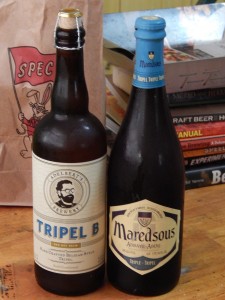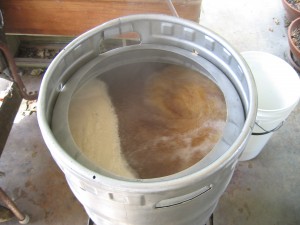 The recipe for a tripel is simple. You’ll need enough Pilsner malt, and roughly 20% sucrose (table sugar), to reach your target original gravity. The Beer Judge Certification Program (BJCP) gives this range as OG 1.075–1.085. Plus, noble hops — all added near the beginning of the boil — to reach your target level of IBUs. The BJCP gives this as 20–40 IBUs. And finally, an attenuative yeast, with a moderately “spicy” Belgian character, to yield a low final gravity (FG). The BJCP gives this as 1.008–1.014 for a corresponding alcohol content of 7.5–9.5%. And that’s it.
The recipe for a tripel is simple. You’ll need enough Pilsner malt, and roughly 20% sucrose (table sugar), to reach your target original gravity. The Beer Judge Certification Program (BJCP) gives this range as OG 1.075–1.085. Plus, noble hops — all added near the beginning of the boil — to reach your target level of IBUs. The BJCP gives this as 20–40 IBUs. And finally, an attenuative yeast, with a moderately “spicy” Belgian character, to yield a low final gravity (FG). The BJCP gives this as 1.008–1.014 for a corresponding alcohol content of 7.5–9.5%. And that’s it.
Tripel (II: Recipe)
Maibock (III: Boiling and Hops)
 Wort production — mashing and running off the wort — for a Maibock is unlikely to cause most homebrewers any problems. For a 5.0-gallon (19-L) batch, you’ll need 11–16 lbs. (5.0–7.3 kg) of grain — assuming you get an extract efficiency between 65 and 80% — to hit your target original gravity (OG 1.064–1.072). If you have a 10-gallon (38-L) or larger mash tun, you’ll have plenty of room.
Wort production — mashing and running off the wort — for a Maibock is unlikely to cause most homebrewers any problems. For a 5.0-gallon (19-L) batch, you’ll need 11–16 lbs. (5.0–7.3 kg) of grain — assuming you get an extract efficiency between 65 and 80% — to hit your target original gravity (OG 1.064–1.072). If you have a 10-gallon (38-L) or larger mash tun, you’ll have plenty of room.
For some homebrewers, however, kettle size may be limiting. Fully-sparged, 11–16 lb. of grain should yield 7 to 10 gallons (26 to 38 L) of pre-boil wort at around 11 °Plato (SG 1.044). If your extract efficiency is on the low end, and you’re shooting for a Maibock on the high end of the OG range, a 10-gallon (38-L) kettle will not be large enough.
To calculate how much pre-boil wort your grain bed will yield, assuming it is fully sparged, multiply your weight of your grain bed (in pounds) times 0.65 gallons per pound — this will give you a rough approximation (in gallons) of the volume of pre-boil wort. If this is more than you can comfortably boil in 90 minutes, you can add more grain to your recipe, but collect less wort. (Estimating how much grain to add can be tricky, though.) You could also supplement your all-grain wort with malt extract. You could also reformulate the recipe for a lower starting gravity.

Recent Comments